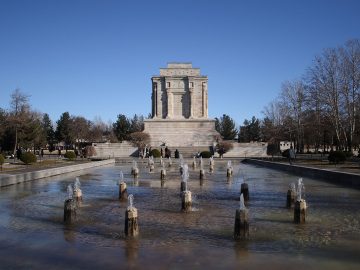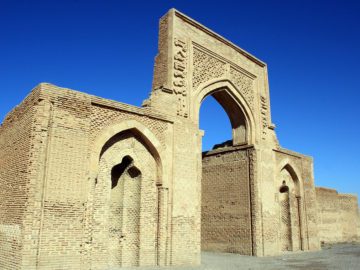Razavi Khorasan province with an area of about 118,851 square kilometers as the fifth largest province in Iran is located in the northeast of the country. It neighbors South Khorasan, Semnan, and North Khorasan provinces, and Turkmenistan and Afghanistan countries. In terms of the population, its center, Mashhad, is the second-most-populous city in Iran, following the capital of Tehran.
Although various Iranian folks originating from different parts of the country are living in this province, the common language is Farsi. Geographically, the province is almost entirely surrounded by mountains including Mount Binalud as the highest point. The province enjoys a dry and semi-arid climate but in the mountainous areas, winters and summers are cold and mild, respectively though, in low-altitude regions, summer is hot and dry.
The Grand Khorasan used to cover south of the Amu Darya and large parts of the current Central Asia countries. During the Sassanid Dynasty (224-651 A.D.), Khorasan was ruled by the army chief Spahbed. After the advent of Islam, this land contained four main cities including Nishabur, Marv, Herat, and Balkh, each of which was the center of Grand Khorasan in different eras.
Al-Ma’mun, the Abbasid Caliph, appointed Tahir ibn Ḥusayn as the governor of Khorasan but in less than a year, Tahir announced independence from Caliph and transferred the capital of Grand Khorasan from Marv to Nishabur, ending the absolute dependency of Iran on the Arab Caliphs. During the Samanid Dynasty (819-999), Khorasan and Mā warāʼ al-Nahr (Transoxiana) were among the brightest regions in the history of Iran because of the flourishment of science, literature, and Persian language.
When the Turks of Ghaznavid Dynasty (977-1186) came to the throne and took ruling of the area, one of the most important incidents of the region’s history namely the division of the Grand Khorasan’s land happened. As a result, a great section of the province with the centrality of Ghazni (Afghanistan) remained under the rule of Ghaznavid, while the rest of it was governed by the Seljuk Dynasty (1037-1194).
In the aftermath of the Mongol invasion in 1219, Tamerlane (reign: 1370-1405) from Samarkand attacked Khorasan for four times. Later, Grand Khorasan became a part of the Safavid Dynasty’s (1501-1736) territory and finally, Nader Shah (reign: 1736-1747) chose Mashhad as capital during the Afsharid Dynasty (1736-1796). After his death, Khorasan came under the control of Afghan commanders but Agha Muhammad Khan Qajar (reign: 1796-1797) took its full control without war and bloodshed and this was kept by his successors during the Qajar Dynasty (1796-1925).
The biggest and most glorious mausoleum of Iran is the holy shrine of the Shiite eighth Imam, Imam Reza (peace be upon Him) located in Mashhad city. Millions of both local and foreign pilgrims and tourists travel to Mashhad every year to visit His shrine.
In addition to the magnificent complex of Astan Quds Razavi (including the Imam Reza holy shrine, Goharshad Mosque, Golden Arch, Allahverdi Khan Portico, Shah Mosque and Bathhouse, and Anthropology Museum), some other tourist attractions of Razavi Khorasan include Ancient Windmills of Nashtifan, Robat-e Sharaf Caravanserai, Tombs of Ferdousi, Nadir Shah Afshar, Farid al-Din Attar, Omar Khayyam, and Kamal-ol-Molk.
Gonabad Qanat is also a historical attraction inscribed on UNESCO World Heritage List.
Some handicrafts of the province include carving on stone, pottery, turquoise stone, silk weaving, and Barak Bafi. The souvenirs of the province are saffron, barberry, pomegranate, spices, perfumes, different types of Nabat (a kind of candy), prayer rug, rings, jewels, and carpet. Shashlik, Shol-e, Eshkaneh, Dizzi Sangi and Balghur Aash are among the local foods. Finally, some of the notable figures of Mashhad are Ferdowsi Tosi (epic poet), Farid al-Din Attar (mystic and poet), Omar Khayyam (poet), Kamal-ol-Molk (painter), Jaber-e bin Hayyan (alchemist, mathematician), Mohammad-Taqi Bahar (poet), Dr. Ali Shariati (sociologist), and Mohammad Reza Shajarian (classic music singer).



